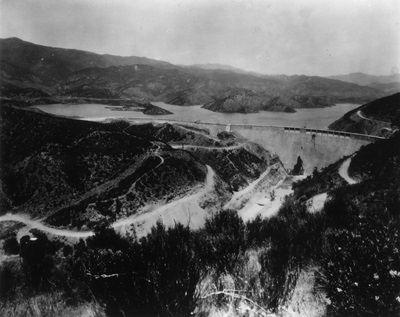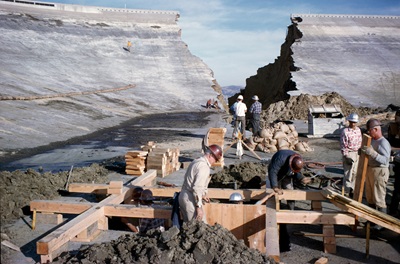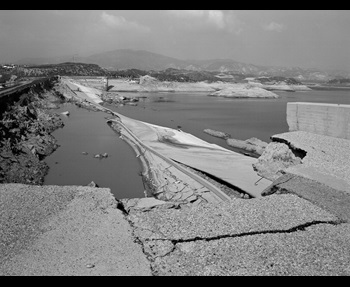History of California Dam Safety
The Division of Safety of Dams (DSOD's) responsibilities have been shaped by incidents at three dams. These historical events directly resulted in the creation, expansion, and transformation of DSOD’s responsibilities and dam safety standards of practice. We now have regulatory oversight of more than 1,250 dams in the state; however, there are some dams in California that don't fall within our jurisdiction.
St. Francis Dam Failure Leads to Creation of the California Dam Safety Program
DSOD was formed as a direct result of one of California's worst catastrophes – the failure of the 2-year old St. Francis Dam in Southern California on the night of March 12, 1928.

The dam’s failure sent a 70-foot wall of water, mud, trees, and boulders crashing down the San Francisquito Canyon into the Santa Clara River Valley, and out to the Pacific Ocean near Oxnard, clearing a 2-mile-wide swath of land 70 miles long. The 5 ½-hour rampage killed more than 450 people, left hundreds more homeless, destroyed 900 houses and many bridges and roads, and swept away 24,000 acres of farmland. This disaster was one of the deadliest in California history, second only to the 1906 San Francisco earthquake.
A state commission reported that the dam failed because it was poorly constructed and located on a geologically unstable site.
The failure of the St. Francis Dam prompted the State Legislature to create the California Dam Safety Program on August 14, 1929 (before the creation of DWR, the program later evolved and became DSOD within DWR). The laws were enacted for the primary purpose of safeguarding life and property. Responsibilities included examination and approval of dams constructed prior to 1929, approval of plans and specifications for new and existing dams, supervision of construction, and supervision over maintenance for all jurisdictional dams.
Baldwin Hills Reservoir Failure Brings Off-Stream Dams into Regulation
Baldwin Hills Reservoir was constructed in 1951 above what is today the Baldwin Hills and Crenshaw neighborhood in the southwest region of Los Angeles.

The failure of Baldwin Hills reservoir is attributed to subsidence beneath the dam that allowed water to seep into the shear zones in the underlying rock causing erosion to rapidly occur to failure. As a result of the failure, 5 people were killed and $15 million in property damages occurred.
The California Water Code was amended in 1965 by legislation to include off-stream storage reservoir under DSOD’s jurisdiction.
The Lower San Fernando Dam Incident Leads to Seismic Re-evaluation Programs

In 1967, on the recommendation of the owner’s consultant and with concurrence by DSOD, the reservoir was operated 10 feet lower than the maximum storage allowance due to the uncertainty of the dam’s construction methods, its history, and the results of the owner’s stability analysis.
The San Fernando earthquake struck on February 9, 1971, causing liquefaction of the dam embankment and foundation materials. Due to the presence of saturated loose-sandy soils, the dam and foundation liquefied and became unstable, causing the upstream slope to slide into the reservoir. This landslide left only about 5 feet of embankment remaining above the reservoir water level.
This landslide resulted in the evacuation of 80,000 people living downstream of the dam while the reservoir was lowered.
As a result of the near embankment failure, the standard of practice for dam evaluation was re-examined, and there was an increase in liquefaction research. The near-failure also prompted DSOD’s seismic re-evaluation programs, which have resulted in numerous seismic retrofits of dams in California.
Contact Us
General Information
Phone: (916) 565-7868 Email: damsafety@water.ca.gov
View additional information on the DSOD contact page.
Street Address:
Division of Safety of Dams
2720 Gateway Oaks Drive, Suite 300
Sacramento, CA 95833
